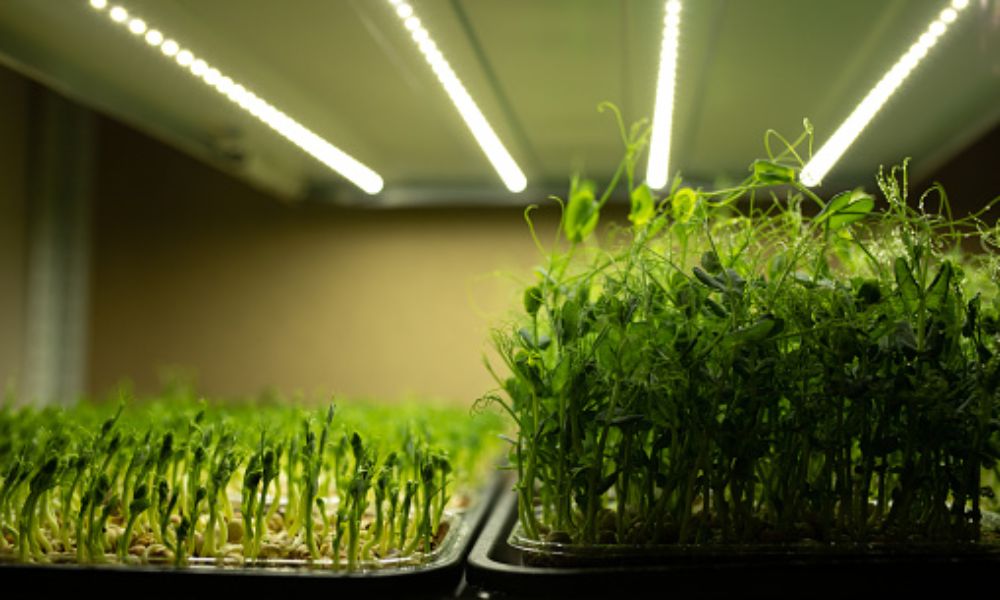When I first started growing seedlings indoors, I had no idea how high my grow lights should be. I placed them way too close, thinking more light meant faster growth—but my poor seedlings ended up looking sunburned instead of strong. That’s when I learned that light distance isn’t just a detail—it’s the key to healthy, sturdy plants. In this guide, I’ll share exactly how high should grow lights be above seedlings, plus what color lights work best and how long to keep them on each day. Whether you’re a new grower or just fine-tuning your setup, I’ll walk you through the simple steps that helped me grow lush, vibrant seedlings at home. Ready to give your little greens the best start?
Why Light Distance Matters for Seedlings
Too close, and young plants can burn. Too far, and they grow weak and thin. The right light distance helps seedlings grow strong, steady, and full of color. It’s the difference between healthy growth and floppy stems. The right light distance keeps seedlings short, strong, and healthy.
Light is food for plants. It gives energy through photosynthesis. Balanced light helps roots grow deep and leaves stay green. Too much heat dries the soil and slows growth. Steady light at the right height supports healthy roots and firm stems.
I once placed my grow light high above my seed tray. The plants stretched tall, pale, and thin. I lowered the light to about 18 inches. In a few days, the leaves darkened, and the stems stood strong. That small change made a big difference. Lowering grow lights by a few inches can turn weak seedlings into healthy ones.
Light distance is simple yet powerful. It shapes every stage of early growth. Good spacing means bright, happy plants ready to thrive.
How High Should Grow Lights Be Above Seedlings
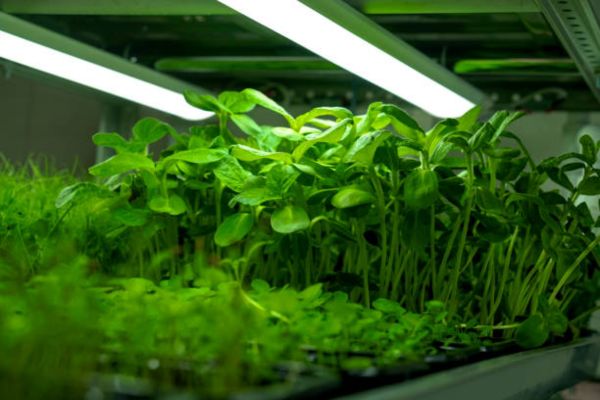
Finding the right height for grow lights sounds hard, but it’s easy once you know the basics. The right distance keeps plants strong and green. Too close burns the leaves. Too far makes them long and weak. Grow lights should stay high enough to spread light but low enough to keep seedlings bright and healthy.
Recommended Height by Grow Light Type
| Grow Light Type | Recommended Distance | Notes |
| LED (Full Spectrum) | 12–24 inches | Start high and lower slowly as plants grow. |
| Fluorescent (T5/T8) | 6–12 inches | Cool lights can stay close to seedlings. |
| HID / CFL | 24–36 inches | Hotter lights need more space to avoid burns. |
LED grow lights work best at 12–24 inches above seedlings. Fluorescent lights can stay closer at 6–12 inches. HID and CFL lights should hang higher, about 24–36 inches. These distances help plants get the right mix of light and heat. Keeping lights at the right height helps seedlings grow short, strong, and green.
As seedlings grow, move the light lower bit by bit. Use adjustable hangers so you can change height easily. Watch how your plants respond. Curled leaves mean too close. Long, thin stems mean too far. The best height keeps light soft, even, and warm—not harsh or hot.
You can test it by hand. Hold your hand at seedling level. Feel the warmth for 30 seconds. Warm is fine; hot is not. That’s your perfect distance. If the light feels too hot for your hand, it’s too close for your seedlings.
Good spacing is a small detail that changes everything. It gives even light, healthy color, and sturdy growth. Strong light from the right height helps seedlings stand tall and thrive. The right grow light height means happy, healthy seedlings every time.
What Color Grow Light Is Best for Seedlings?
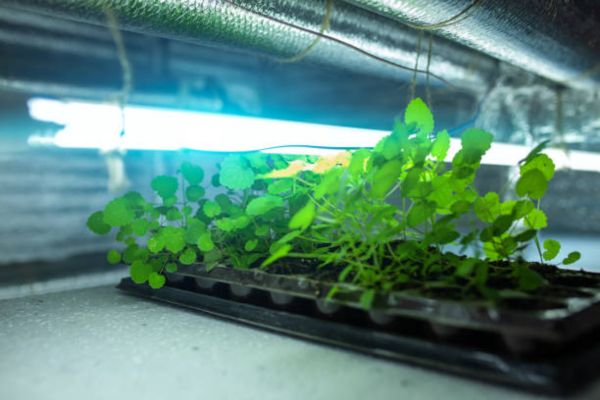
Color matters more than many new growers think. The right color light shapes how seedlings grow, look, and stay strong. The best color grow light for seedlings is a full-spectrum light that combines both blue and red tones.
Blue light helps seedlings grow short and sturdy. It builds thick stems and strong leaves. Without enough blue, plants stretch and look pale. Blue light keeps seedlings compact and full of healthy green leaves.
Red light works in the next stage of growth. It helps with leaf expansion and prepares plants for flowering later. Red light alone can make seedlings tall and thin, so it’s best mixed with blue for balance. Red light supports stem and leaf growth but needs blue light to keep plants firm.
The best option is a full-spectrum or balanced LED light. These lights blend blue, red, and white to copy natural sunlight. They help plants grow evenly from seed to transplant. A full-spectrum LED grow light gives seedlings the perfect mix of colors for steady, healthy growth.
In my setup, I use a 4000–6500K full-spectrum LED. The cool white tone gives the right amount of blue light while adding warmth from red. My seedlings stay short, rich in color, and strong enough for outdoor planting. Full-spectrum LEDs in the 4000–6500K range give seedlings their best start.
Full-spectrum LEDs combine blue and red tones for safe, effective growth. Curious about light safety? Read are grow lights bad for humans to learn how to use them safely at home.
How Long Should Grow Lights Be On for Seedlings
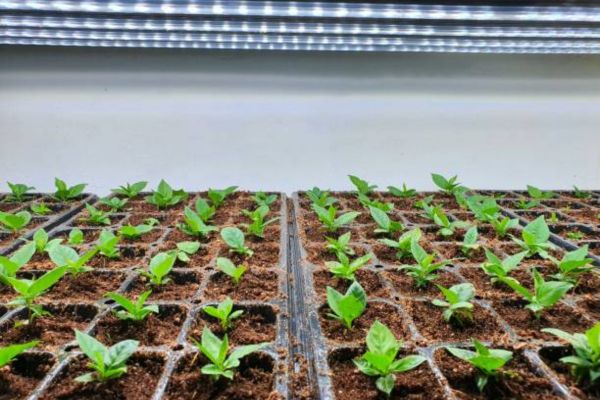
Light time shapes how well seedlings grow. Grow lights should stay on for 14 to 16 hours each day. This gives steady energy and keeps plants short, green, and strong. A set routine helps seedlings build roots and healthy leaves.
Dark hours are just as vital. In the dark, plants rest and use stored energy. Constant light tires them out and slows growth. Seedlings need about 8 hours of darkness for balance and strength.
A timer makes this easy. Set it once, and the light will turn on and off at the same time daily. That steady cycle builds strong habits for healthy growth. A grow light timer keeps seedlings on a steady schedule with no stress.
Seedlings tell you how they feel. Long, pale stems mean they need more light. Curled or dry leaves mean too much. Bright color and firm stems show they’re happy. Healthy seedlings grow best under 14 to 16 hours of steady light each day.
Common Mistakes to Avoid
Small mistakes can stop seedlings from growing well. The most common issue is light distance. Too close burns the leaves. Too far makes them weak and thin. Keeping the right space between grow lights and seedlings keeps growth steady and safe.
Another mistake is not changing light height as plants grow. Seedlings grow fast and need room. Fixed lights can cause uneven light or heat. Raising or lowering lights often keeps seedlings bright and balanced.
Color matters too. Using only warm or red light can make plants tall but weak. A mix of blue and red gives better shape and color. The right light spectrum builds strong stems and green leaves.
Many growers also leave lights on all day. Plants need rest to grow roots and store energy. Too much light can dry them out. Turning lights off for at least 8 hours helps seedlings stay strong.
Reflective walls are often ignored. Plain dark walls waste light. Mylar sheets or white walls help bounce light around evenly. Reflective surfaces make sure every seedling gets enough light to grow.
My Personal Grow Light Routine (Step-by-Step)
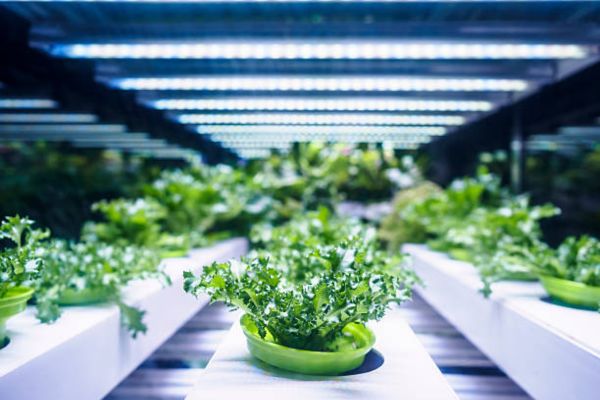
Over time, I’ve found a simple routine that keeps my seedlings strong and healthy. It took trial and error, but these steps work every time. A clear plan helps seedlings grow evenly and stay bright from start to finish.
Step 1: Choose an adjustable LED grow light.
I prefer full-spectrum LEDs because they give both blue and red light. They stay cool, save energy, and work for every stage of growth. An adjustable LED light gives the right mix of color and heat for steady growth.
Step 2: Start at 18–20 inches above seedlings.
This height spreads light evenly without burning the leaves. The seedlings get enough energy to grow but stay compact. Keeping lights 18–20 inches above seedlings supports firm stems and green leaves.
Step 3: Run lights 16 hours per day using a timer.
A timer keeps the routine steady. It turns the lights on and off at the same time each day. A 16-hour light cycle gives seedlings enough energy while allowing rest.
Step 4: Lower lights as seedlings strengthen.
As plants grow taller, I move the light a little closer. This keeps the same brightness and stops stretching. Lowering lights slowly helps maintain even, healthy growth.
Step 5: Watch leaf color and stem length for feedback.
Bright green leaves and firm stems mean the setup is perfect. Pale color or long stems show the light is too far. Healthy color and shape tell you the distance and timing are right.
At first, I made every mistake—lights too high, too close, too long. After testing and watching closely, I learned that small changes matter most. What I learned: balance brings results—steady light, right height, and daily care make all the difference.
Pro Tips for Stronger Seedlings
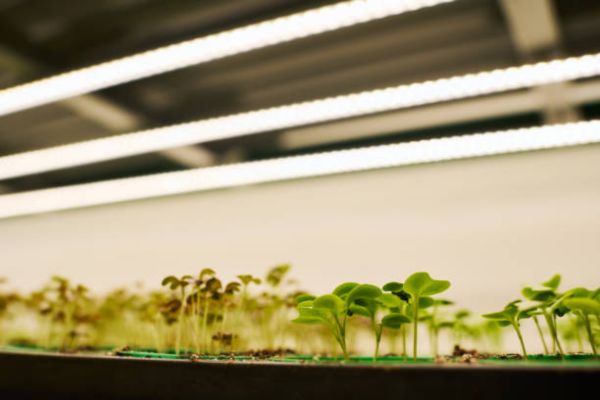
A few small habits can make a big difference in how your seedlings grow. These simple steps help plants stay sturdy, even, and full of life. Good light, clean tools, and the right setup lead to strong, healthy seedlings.
Use reflective panels or foil around your grow area. This bounces light onto every side of the plants and reduces shadows. Reflective surfaces help seedlings get even light from all directions.
Rotate your trays each day. This stops plants from leaning toward one side. It also helps every seedling grow straight and balanced. Turning trays daily keeps stems even and strong.
Keep the room warm and moist. The best range is between 65°F and 75°F with gentle humidity. Too cold slows growth, while dry air weakens leaves. Steady warmth and soft moisture create the perfect growing space.
Clean your grow lights often. Dust can block brightness and lower light quality. Wipe them gently every week to keep light levels high. Clean lights shine brighter and help seedlings grow faster.
Each small detail adds up to big results. With steady care and small daily checks, your seedlings will grow strong, green, and ready for transplanting. Simple, steady care builds stronger seedlings every time.
FAQs
How do I know seedlings get enough light?
Healthy seedlings look short and firm with bright green leaves. Long, pale stems mean they need more light. Strong color and steady height show seedlings are getting the right light.
Should grow lights stay on 24 hours a day?
No. Plants need rest just like people. Darkness helps them use stored energy and grow roots. Give seedlings at least 8 hours of darkness to stay healthy and balanced.
What’s the ideal light schedule for seedlings?
Keep lights on for 14 to 16 hours each day, then turn them off for 8 to 10 hours. A timer makes this easy and keeps the routine steady. A 14–16 hour light cycle supports strong growth and deep green color.
Conclusion
Getting the light setup right makes all the difference. The right distance keeps seedlings safe from heat. The right color helps them grow strong and green. Right timing gives them balance and steady growth. Strong seedlings need proper height, full-spectrum light, and 14–16 hours of gentle brightness each day.
I’ve made every mistake—from lights too close to running them all night. Each time, the plants showed me what they needed. Once I found the right mix of height, color, and timing, my seedlings grew faster, stronger, and healthier. A balanced light setup turned my weak plants into thriving seedlings ready for the garden.

